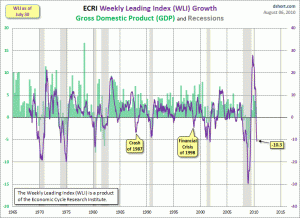Home » forecasting
Category Archives: forecasting
The US is still under recession watch
In the last summer, David Rosenberg made the recession call – he’s 99% sure the US will slip into recession. Despite a very volatile second half of 2011, the recent data on unemployment, consumer confidence and housing sales all seemed to indicate the US economy is getting better.
But according to the leading economic indicator, shown below, the US economy is still pretty much under recession-watch territory. Since late 1960s, the indicator only missed once in predicting the onset of recession — the second half of 2010. In other words, at the current level of the index, there is a very high risk that the economy is likely to head down, not up. So will the indicator miss the target again, or we are indeed heading into another recession in 2012?
[singlepic id=32 w=400 h=300 float=]
In the following video interview, the author of ECRI leading indicator explains to Bloomberg’s Tom Keen why he thinks the US is still not out of woods yet.
Copper signals another global slowdown
Copper has been a good predictor for the health of the global economy. It is sometimes called Dr. Copper by fans because it’s seen as a better prognosticator of the economy than academics with Ph.D.s.
Copper price dropped 22% in September, and this was coincided with a nearly 10% fall in the Shanghai stock market since the end of July, and a 21% drop in Hong Kong’s Hang Seng Index.
More headwinds ahead…
Jan Hazius on economic outlook
Interview of Goldman Sachs chief US economist Jan Hazius, on the economic outlook. He predicts housing price will keep going down.
Business cycle indicator says double-dip is likely
ECRI WLI index says there is a fair chance that double-dip is coming. Here is an analysis I borrowed from dshort.com.
(click to enlarge; graph courtesy of dshort.com)
According to dshort:
A significant decline in the WLI has been a leading indicator for six of the seven recessions since the 1960s. It lagged one recession (1981-1982) by nine weeks. The WLI did turned negative 17 times when no recession followed, but 14 of those declines were only slightly negative (-0.1 to -2.4) and most of them reversed after relatively brief periods.
Three of the false negatives were deeper declines. The Crash of 1987 took the Index negative for 68 weeks with a trough of -6.8. The Financial Crisis of 1998, which included the collapse of Long Term Capital Management, took the Index negative for 23 weeks with a trough of -4.5. The third significant false negative came near the bottom of the bear market of 2000-2002, about nine months after the brief recession of 2001. At the time, the WLI seemed to be signaling a double-dip recession, but the economy and market accelerated in tandem in the spring of 2003, and a recession was avoided.
The question, of course, is whether the latest WLI decline is a leading indicator of a recession or a false negative. The index has never dropped to the current level without the onset of a recession. The deepest decline without a near-term recession was in the Crash of 1987, when the index slipped to -6.8.
A debate on where the US economy is headed
I am leaning toward Rosenberg’s view on this.
New financial indicator predicts downturn ahead
A new financial indicator predicts economy is likely to suffer downturn ahead.
This is from Jim Hamilton’s Econbrowser blog. More details about this new indicator.
Most recently, researchers have tried to gauge the degree of financial stress using indicators such as the LIBOR-OIS spread ([1], [2]) or deviations of yields from predictions of interest rate models (e.g., the recent paper by Christensen, Lopez, and Rudebusch). There are also a number of composite indexes that various private-sector analysts rely on, such as the Bloomberg financial conditions index.
Two private-sector analysts (Jan Hatzius of Goldman Sachs and Peter Hooper of Deutsche Bank) have recently teamed up with three academics (Rick Mishkin of Columbia, Kermit Schoenholtz of NYU, and Mark Watson of Princeton) to produce a new financial conditions index that attempts to combine the information of 44 separate series including those mentioned above along with a great number of others. One of the differences between their approach and previous work is that HHMSW seek to isolate the separate information of the financial indicators from aggregate business cycle movements by looking at the residuals from a regression of each indicator on lags of inflation and real GDP growth rates.




